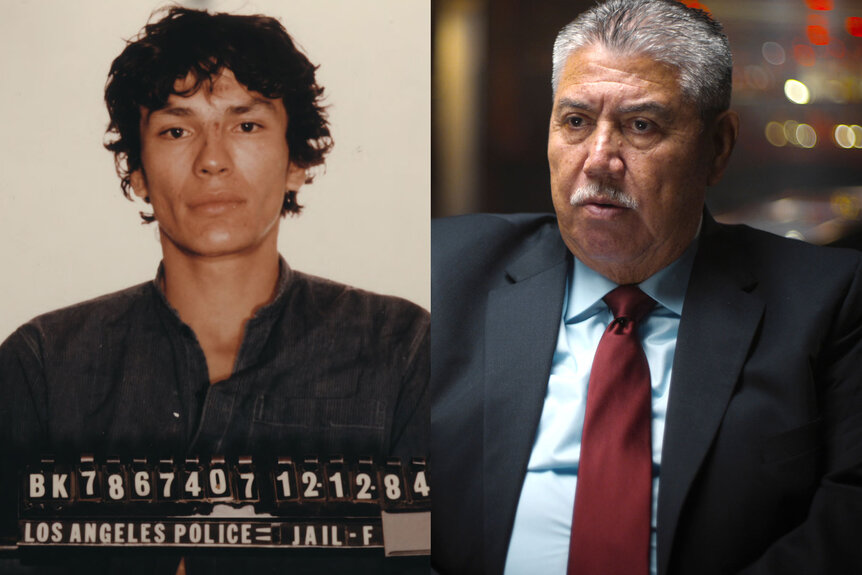Create a free profile to get unlimited access to exclusive videos, breaking news, sweepstakes, and more!
What Made A Young Detective Realize That A Range Of Seemingly Random Crimes Were The Work Of The 'Night Stalker'?
Los Angeles County Sheriff's Department Det. Gil Carrillo was the youngest homicide detective on the force when he put forth the unprecedented but ultimately correct theory that a string of rapes, murders and other assaults in the mid-1980s were the work of one person.

When a series of rapes, murders and other assaults began to sweep over Los Angeles in the mid-1980s, law enforcement treated them as what they appeared to be on the surface: random attacks that were in no way connected. But they would ultimately be revealed to be the work of one man — Richard Ramirez, the infamous "Night Stalker" — thanks to the intuition, imagination, and university training of a fresh-faced detective.
Ramirez's crimes were all over the place in nature, from his choice of weapons to the profiles of his victims, to the crimes themselves, which ranged from molestation to rape to murder. Sometimes he'd kidnap children and let them go; other times he'd rape and kill adults.
Most criminals don’t have so much range. In fact, as Los Angeles County Sheriff's Department Gil Carrillo told Oxygen.com, there aren't any other documented cases in which one person lashed out at his victims in such a disparate manner. So it’s no surprise that detectives initially thought Ramirez’s crimes were random, committed by different people.
However, Carrillo told Oxygen.com that by April 1985, he suspected that they had a single serial killer on their hands. Even though he had been with the department for four years at this point, he said he was still considered a "rookie" due to his relative inexperience and his outlandish theory was initially dismissed.
“I tried to explain that as early as April 10 to the guys up in Monterey Park and it just wouldn’t go,” Carrillo explained to Oxygen.com.
By this point, five people had been murdered and even more had been victimized in other ways. Jennie Vincow was found raped and killed at her Eagle Rock home with her throat slashed in June 1984. The following February, 6-year-old Anastasia Hronas was abducted from her home and molested, but then let go. On March 17, 1985, Tsai-lian Yu of Monterey Park was pulled from her car and shot to death on the same day that Dayle Okazaki was gunned down in her Rosemead condo. Okazaki's roommate Marie Hernandez suffered a gunshot wound but survived. Vincent Zazzara and Maxine Zazzara were also found murdered in their Whittier home that month. The couple had both been shot but Maxine was also raped, stabbed and her eyes were missing.
Carrillo told Oxygen.com that he began thinking about what he learned at California State University, Los Angeles. He had a professor named Robert Morneau who taught an advanced class on sex crimes. It was this class that made him think there was a sexually motivated serial killer at work.
Carrillo said it was clear that, especially in the Okazaki and Yu crime scenes, the killer thoroughly enjoyed seeing his victims scared. Yu was pulled out of her car rather than being shot in it, thus Carrillo believed that the killer wanted a confrontation. He theorized that the killer also waited for Okazaki to see him before he killed her because he derived pleasure from that.
“It all came from two semesters of [this class],” he said. “Dr. Morneau gave me the insight on sex crimes. [...] Some of the things that he talked about in sex crimes came out and were recognizable to me. The fear factor, looking to people's fear, he was getting off on that. There was a sexual deviancy to it.”
Furthermore, as he notes in Netflix’s docuseries “Night Stalker: The Hunt for a Serial Killer,” he took a sketch based on Hernandez’s recollection down to a colleague, who showed him another sketch of an attempted kidnapping in Pico Rivera.
He began seriously thinking this was all the morbid work of one man.
But it was an uphill battle convincing his colleagues.
“I could see it but unless you had the education or whatever that I had, it was a tough pill to swallow,” Carillo told Oxygen.com. “Nobody in criminal history had been documented doing this stuff.”
However, seasoned Los Angeles County Sheriff’s Office Det. Frank Salerno, began to believe in his theory. And Salerno had a lot of credibility within the department, having “played a key role” in the "Hillside Strangler" case, according to a 1985 Los Angeles Times piece.
The two teamed up and began leading their department's investigation into the elusive "Night Stalker."
“It was extremely challenging to get people to believe and it truly wasn’t easy to convince anybody until Salerno said that this was in fact a serial killer,” Carrillo told Oxygen.com. “Once the experienced man said it, then people started believing."
Not everyone, however. He added that both a psychologist from New York and one from UCLA stated that they were both “full of hot air” because it was impossible that one person could be behind such a pattern.
“We proved them wrong,” Carrillo said.
Carrillo's instinct was dead on and Ramirez was arrested in August 1985. By 1989, he was convicted of 13 murders, five attempted murders, 11 sexual assaults, and 14 burglaries and was sentenced to death. He died in 2013 of lymphoma while still on death row.
Carrillo and Salerno hope that other homicide detectives will learn from their experience. Carrillo said that most people, up until the release of the docuseries, didn't realize that some criminals could exhibit such a range of illicit behavior, as the child molestation element of the case hadn't been common knowledge.
“One of the things about homicide investigations is that you have to keep an open mind,” Salerno told Oxygen.com, even if something doesn’t “seem possible” or “plausible” at first.
The now-retired detectives note that while they were the lead investigators at their office, many other departments worked on the case and more than 150 officers involved celebrated Ramirez’s arrest with a barbecue.



























